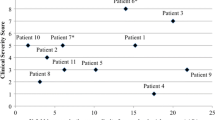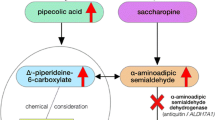Abstract
To facilitate clinical research on pyridoxine-dependent seizures (PDS), a rare disease registry was established for affected patients in the United States and Canada. From 1999 to 2007, 63 cases, ranging in age from 11 months to 40 years, were registered. All registered cases were diagnosed with PDS by their physicians using clinical criteria. Seventy percent of the cases presented with neonatal seizures, and the mean lag time between presentation and diagnosis was 313 days. Pyridoxine treatment regimens were varied, ranging from 50 to 2,500 mg per day (1.4 to 67.8 mg/kg/day). While 47 of the cases were seizure-free on pyridoxine monotherapy, over time, eight other cases also required the concomitant use of anticonvulsants for effective seizure control, while the remainder continued to have recurrent seizures, despite the use of pyridoxine and multiple anticonvulsants. Our review of this collection of cases suggests that, for some registered individuals, either pyridoxine may be acting as an adjunctive anticonvulsant or the patient may have developed a secondary etiology for seizures. In addition, some of these cases may have pyridoxine-responsive seizures (PRS) rather than pyridoxine-dependency. Four adult and seven school-aged cases were described as developmentally normal, while the other cases had a variety of neurodevelopmental handicaps. Twenty-five percent of the cases required the pharmacologic treatment of behavioral symptoms. Clinicians caring for neonates and other young patients with intractable seizures do not necessarily consider PDS as an etiology; therefore, certain cases may be undiagnosed or diagnosed late in the course of their evaluation and treatment. As the diagnosis of PDS can now be confirmed by genetic and biochemical testing, formal screening protocols for this disorder should be developed. Patients previously diagnosed with PDS by clinical criteria should also receive confirmatory testing.
Similar content being viewed by others
Abbreviations
- PDS:
-
Pyridoxine-dependent seizures
- PRS:
-
Pyridoxine-responsive seizures
- PA:
-
Pipecolic acid
- AASA:
-
α-aminoadipic semialdehyde
- P5P:
-
Pyridoxal-5-phosphate
- OCD:
-
Obsessive compulsive disorder
- AD:
-
Autistic disorder
- PDD:
-
Pervasive developmental disorder, not otherwise specified
- BPSU:
-
British Paediatric Surveillance Unit
References
Alkan A, Kutlu R, Aslan M, Sigirci A, Orkan I, Yakinci C (2004) Pyridoxine-dependent seizures: magnetic resonance spectroscopy findings. J Child Neurol 19:75–78. doi:10.1177/08830738040190010712
Bass NE, Wyllie E, Cohen B, Joseph SA (1996) Pyridoxine-dependent epilepsy: the need for repeated pyridoxine trials and the risk of severe electrocerebral suppression with intravenous pyridoxine infusion. J Child Neurol 11:422–424
Baxter P (1999) Epidemiology of pyridoxine dependent and pyridoxine responsive seizures in the UK. Arch Dis Child 81:431–433
Baxter P (2001) Pyridoxine dependent and pyridoxine responsive seizures. In: Baxter P (ed) Vitamin responsive conditions in paediatric neurology. Mac Keith Press, London, pp 109–165
Baxter P, Griffiths P, Kelly T, Gardner-Medwin D (1996) Pyridoxine-dependent seizures: demographic, clinical, MRI and psychometric features, and effect of dose on intelligence quotient. Dev Med Child Neurol 38:998–1006
Baynes K, Farias ST, Gospe SM Jr (2003) Pyridoxine-dependent seizures and cognition in adulthood. Dev Med Child Neurol 45:782–785. doi:10.1017/S0012162203001440
Been JV, Bok LA, Andriessen P, Renier WO (2005) Epidemiology of pyridoxine dependent seizures in the Netherlands. Arch Dis Child 90:1293–1296. doi:10.1136/adc.2005.075069
Berger AR, Schaumburg HH, Schroeder C, Apfel S, Reynolds R (1992) Dose response, coasting, and differential fiber vulnerability in human toxic neuropathy: a prospective study of pyridoxine neurotoxicity. Neurology 42:1367–1370
Bok LA, Struys E, Willemsen MA, Been JV, Jakobs C (2007) Pyridoxine-dependent seizures in Dutch patients: diagnosis by elevated urinary alpha-aminoadipic semialdehyde levels. Arch Dis Child 92:687–689. doi:10.1136/adc.2006.103192
Chou ML, Wang HS, Hung PC, Sun PC, Huang SC (1995) Late-onset pyridoxine-dependent seizures: report of two cases. Acta Paediatr Sin 36:434–437
Coker SB (1992) Postneonatal vitamin B6-dependent epilepsy. Pediatrics 90:221–223
Ebinger M, Schultze C, König S (1999) Demographics and diagnosis of pyridoxine-dependent seizures. J Pediatr 134:795–796
Frye RE, Donner E, Golja A, Rooney CM (2003) Folinic acid-responsive seizures presenting as breakthrough seizures in a 3-month-old boy. J Child Neurol 18:562–569. doi:10.1177/08830738030180081001
Gospe SM Jr (2006) Pyridoxine-dependent seizures: new genetic and biochemical clues to help with diagnosis and treatment. Curr Opin Neurol 19:148–153. doi:10.1097/01.wco.0000218230.81301.12
Gospe SM Jr, Hecht ST (1998) Longitudinal MRI findings in pyridoxine-dependent seizures. Neurology 51:74–78
Goutières F, Aicardi J (1985) Atypical presentations of pyridoxine-dependent seizures: a treatable cause of intractable epilepsy in infants. Ann Neurol 17:117–120. doi:10.1002/ana.410170203
Grillo E, da Silva RJM, Barbato JH Jr (2001) Pyridoxine-dependent seizures responding to extremely low-dose pyridoxine. Dev Med Child Neurol 43:413–415. doi:10.1017/S0012162201000767
Haenggeli C-A, Girardin E, Paunier L (1991) Pyridoxine-dependent seizures, clinical and therapeutic aspects. Eur J Pediatr 150:452–455. doi:10.1007/BF01958419
Hoffmann GF, Schmitt B, Windfuhr M, Wagner N, Strehl H, Bagci S et al (2007) Pyridoxal 5′-phosphate may be curative in early-onset epileptic encephalopathy. J Inherit Metab Dis 30:96–99. doi:10.1007/s10545-006-0508-4
Hunt AD Jr, Stokes J Jr, McCrory WW, Stroud HH (1954) Pyridoxine dependency: report of a case of intractable convulsions in an infant controlled by pyridoxine. Pediatrics 13:140–145
Hyland K, Buist NR, Powell BR, Hoffman GF, Rating D, McGrath J et al (1995) Folinic acid responsive seizures: a new syndrome? J Inherit Metab Dis 18:177–181. doi:10.1007/BF00711760
Kanno J, Kure S, Narisawa A, Kamada F, Takayanagi M, Yamamoto K et al (2007) Allelic and non-allelic heterogeneities in pyridoxine dependent seizures revealed by ALDH7A1 mutational analysis. Mol Genet Metab 91:384–389. doi:10.1016/j.ymgme.2007.02.010
McLachlan RS, Brown WF (1995) Pyridoxine dependent epilepsy with iatrogenic sensory neuronopathy. Can J Neurol Sci 22:50–51
Mikati MA, Trevathan E, Krishnamoorthy KS, Lombroso CT (1991) Pyridoxine-dependent epilepsy: EEG investigations and long-term follow-up. Electroencephalogr Clin Neurophysiol 78:215–221. doi:10.1016/0013-4694(91)90035-3
Mills PB, Surtees RAH, Champion MP, Beesley CE, Dalton N, Scambler PJ et al (2005) Neonatal epileptic encephalopathy caused by mutations in the PNPO gene encoding pyridox(am)ine 5′-phosphate oxidase. Hum Mol Genet 14:1077–1086. doi:10.1093/hmg/ddi120
Mills PB, Struys E, Jakobs C, Plecko B, Baxter P, Baumgartner M et al (2006) Mutations in antiquitin in individuals with pyridoxine-dependent seizures. Nat Med 12:307–309. doi:10.1038/nm1366
Nabbout R, Soufflet C, Plouin P, Dulac O (1999) Pyridoxine dependent epilepsy: a suggestive electroclinical pattern. Arch Dis Child Fetal Neonatal Ed 81:F125–F129
Ohtahara S, Ohtsuka Y, Yamatogi Y, Oka E, Yoshinaga H, Sato M (1993) Prenatal etiologies of West syndrome. Epilepsia 34:716–722. doi:10.1111/j.1528-1157.1993.tb00451.x
Pearl PL, Gospe SM (2007) Pyridoxal phosphate dependency, a newly recognized treatable catastrophic epileptic encephalopathy. J Inherit Metab Dis 30:2–4. doi:10.1007/S10545-008-9974-1
Plecko B, Stöckler-Ipsiroglu S, Paschke E, Erwa W, Struys EA, Jakobs C (2000) Pipecolic acid elevation in plasma and cerebrospinal fluid of two patients with pyridoxine-dependent epilepsy. Ann Neurol 48:121–125. doi:10.1002/1531-8249(200007)48:1<121::AID-ANA20>3.0.CO;2-V
Plecko B, Hikel C, Korenke G-C, Schmitt B, Baumgartner M, Baumeister F et al (2005) Pipecolic acid as a diagnostic marker of pyridoxine-dependent epilepsy. Neuropediatrics 36:200–205. doi:10.1055/s-2005-865727
Plecko B, Paul K, Paschke E, Stoeckler-Ipsiroglu S, Struys E, Jakobs C et al (2007) Biochemical and molecular characterization of 18 patients with pyridoxine-dependent epilepsy and mutations of the antiquitin (ALDH7A1) gene. Hum Mutat 28:19–26. doi:10.1002/humu.20433
Rankin PM, Harrison S, Chong WK, Boyd S, Aylett SE (2007) Pyridoxine-dependent seizures: a family phenotype that leads to severe cognitive deficits, regardless of treatment regime. Dev Med Child Neurol 49:300–305
Salomons GS, Bok LA, Struys EA, Pope LL, Darmin PS, Mills PB et al (2007) An intriguing “silent” mutation and a founder effect in antiquitin (ALDH7A1). Ann Neurol 62:414–418. doi:10.1002/ana.21206
Schaumburg H, Kaplan J, Windebank A, Vick N, Rasmus S, Pleasure D et al (1983) Sensory neuropathy from pyridoxine abuse. A new megavitamin syndrome. N Engl J Med 309:445–448
Shih JJ, Kornblum H, Shewmon DA (1996) Global brain dysfunction in an infant with pyridoxine dependency: evaluation with EEG, evoked potentials, MRI, and PET. Neurology 47:824–826
Struys EA, Jakobs C (2007) Alpha-aminoadipic semialdehyde is the biomarker for pyridoxine dependent epilepsy caused by alpha-aminoadipic semialdehyde dehydrogenase deficiency. Mol Genet Metab 91:405. doi:10.1016/j.ymgme.2007.04.016
Wang H-S, Kuo M-F, Chou M-L, Hung P-C, Lin K-L, Hsieh M-Y et al (2005) Pyridoxal phosphate is better than pyridoxine for controlling idiopathic intractable epilepsy. Arch Dis Child 90:512–515. doi:10.1136/adc.2003.045963
Yoshii A, Takeoka M, Kelly PJ, Krishnamoorthy KS (2005) Focal status epilepticus as atypical presentation of pyridoxine-dependent epilepsy. J Child Neurol 20:696–698. doi:10.1177/08830738050200081301
Acknowledgments
The authors wish to thank Mary Voeller, Natalia Oster, Cathy Graubert, and Janna Stults for their assistance with this study, and Dr. Russell Saneto for reviewing the manuscript.
Author information
Authors and Affiliations
Corresponding author
Additional information
This work was supported by the research endowments of the Division of Pediatric Neurology, Children’s Hospital and Regional Medical Center, Seattle, WA.
Rights and permissions
About this article
Cite this article
Basura, G.J., Hagland, S.P., Wiltse, A.M. et al. Clinical features and the management of pyridoxine-dependent and pyridoxine-responsive seizures: review of 63 North American cases submitted to a patient registry. Eur J Pediatr 168, 697–704 (2009). https://doi.org/10.1007/s00431-008-0823-x
Received:
Revised:
Accepted:
Published:
Issue Date:
DOI: https://doi.org/10.1007/s00431-008-0823-x




